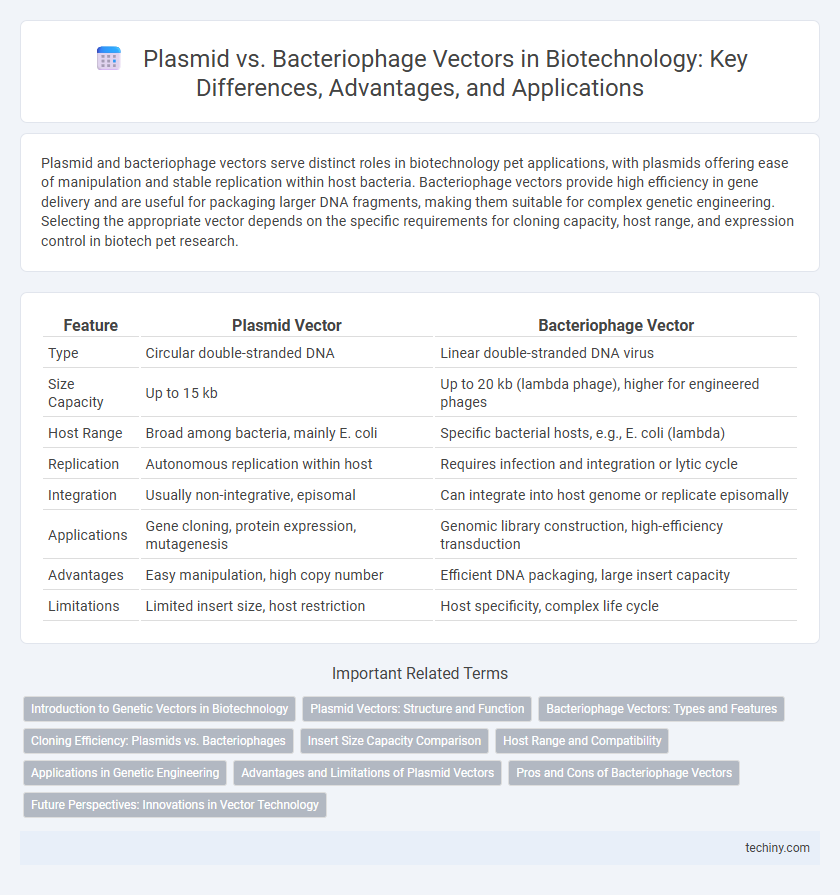Plasmid and bacteriophage vectors serve distinct roles in biotechnology pet applications, with plasmids offering ease of manipulation and stable replication within host bacteria. Bacteriophage vectors provide high efficiency in gene delivery and are useful for packaging larger DNA fragments, making them suitable for complex genetic engineering. Selecting the appropriate vector depends on the specific requirements for cloning capacity, host range, and expression control in biotech pet research.
Table of Comparison
| Feature | Plasmid Vector | Bacteriophage Vector |
|---|---|---|
| Type | Circular double-stranded DNA | Linear double-stranded DNA virus |
| Size Capacity | Up to 15 kb | Up to 20 kb (lambda phage), higher for engineered phages |
| Host Range | Broad among bacteria, mainly E. coli | Specific bacterial hosts, e.g., E. coli (lambda) |
| Replication | Autonomous replication within host | Requires infection and integration or lytic cycle |
| Integration | Usually non-integrative, episomal | Can integrate into host genome or replicate episomally |
| Applications | Gene cloning, protein expression, mutagenesis | Genomic library construction, high-efficiency transduction |
| Advantages | Easy manipulation, high copy number | Efficient DNA packaging, large insert capacity |
| Limitations | Limited insert size, host restriction | Host specificity, complex life cycle |
Introduction to Genetic Vectors in Biotechnology
Plasmids and bacteriophage vectors are crucial tools in genetic engineering, facilitating gene cloning and expression in host organisms. Plasmids are circular DNA molecules that replicate independently within bacterial cells, offering high copy numbers and ease of manipulation for gene insertion. Bacteriophage vectors, derived from viruses that infect bacteria, enable efficient DNA packaging and transfer, often providing larger cloning capacity and specialized delivery mechanisms compared to plasmids.
Plasmid Vectors: Structure and Function
Plasmid vectors are circular, double-stranded DNA molecules commonly used in genetic engineering due to their ability to replicate independently within bacterial cells. Their structure typically includes an origin of replication (Ori), selectable marker genes, and multiple cloning sites (MCS) that facilitate the insertion and expression of foreign DNA. These vectors enable efficient gene cloning, protein expression, and functional studies in biotechnology applications.
Bacteriophage Vectors: Types and Features
Bacteriophage vectors are viral particles used to deliver genetic material into bacterial cells, with types including lambda phage, M13 phage, and T4 phage vectors, each exhibiting unique packaging capacities and lifecycles. Lambda phage vectors accommodate large DNA inserts up to 20 kb and undergo a lytic or lysogenic cycle, making them useful for genomic library construction. M13 phage vectors enable single-stranded DNA replication, ideal for mutagenesis and sequencing applications, while T4 phage vectors offer high packaging capacity and efficient infection rates for gene cloning.
Cloning Efficiency: Plasmids vs. Bacteriophages
Plasmid vectors generally exhibit higher cloning efficiency for smaller DNA fragments due to their stable replication and ease of manipulation in bacterial hosts. Bacteriophage vectors, such as lambda phages, enable the cloning of larger DNA inserts with moderate efficiency but offer advantages in packaging and infection processes. Understanding the trade-offs in cloning capacity and transformation efficiency guides vector selection for specific molecular cloning applications in biotechnology.
Insert Size Capacity Comparison
Plasmid vectors typically accommodate insert sizes ranging from 1 to 15 kilobases, making them suitable for cloning smaller DNA fragments. In contrast, bacteriophage vectors, such as lambda phage, can carry larger inserts up to 20 kilobases, enhancing their utility for intermediate-sized genomic fragments. This difference in insert size capacity is critical for selecting appropriate vectors in genetic engineering and molecular cloning applications.
Host Range and Compatibility
Plasmid vectors typically exhibit a narrower host range, primarily compatible with specific bacterial species such as Escherichia coli, making them ideal for cloning and protein expression in well-characterized hosts. Bacteriophage vectors possess broader or more specialized host ranges, depending on the phage type, enabling infection and genetic material delivery into diverse bacterial strains, including those less accessible to plasmids. Compatibility considerations involve plasmid replication origin compatibility and phage receptor recognition, critically influencing vector selection for targeted genetic engineering in bacterial hosts.
Applications in Genetic Engineering
Plasmid vectors are widely used in genetic engineering for cloning, gene expression, and recombinant protein production due to their ability to replicate independently in bacterial hosts. Bacteriophage vectors offer advantages in transduction and genome integration, facilitating targeted gene delivery and phage display techniques. The choice between plasmid and bacteriophage vectors depends on the specific application, such as temporary gene expression or stable genome modification in biotechnology research and therapeutic development.
Advantages and Limitations of Plasmid Vectors
Plasmid vectors offer high cloning capacity, ease of manipulation, and stable replication in bacterial hosts, making them ideal for gene cloning and protein expression. Their limitations include size constraints compared to bacteriophages, lower efficiency in gene delivery to certain hosts, and potential instability in large-scale applications. Despite these challenges, plasmids remain a fundamental tool in molecular biology due to their versatility and well-characterized nature.
Pros and Cons of Bacteriophage Vectors
Bacteriophage vectors offer high transduction efficiency and accommodate larger DNA inserts compared to plasmid vectors, making them suitable for complex genomic libraries and gene therapy applications. They exhibit specificity to bacterial hosts, reducing off-target effects, but this can limit their use across diverse bacterial species. However, challenges include their more complex manipulation, potential immunogenicity, and limited stability outside host cells, which can hinder large-scale production and storage.
Future Perspectives: Innovations in Vector Technology
Advancements in plasmid and bacteriophage vector technology are driving next-generation genetic engineering with enhanced delivery efficiency and specificity. Innovations such as synthetic biology-inspired vector redesign and CRISPR-based targeting expand the versatility and precision of gene therapy applications. Future perspectives emphasize integrating artificial intelligence and high-throughput screening to optimize vector performance and reduce immunogenicity in clinical settings.
Plasmid vs Bacteriophage Vector Infographic

 techiny.com
techiny.com